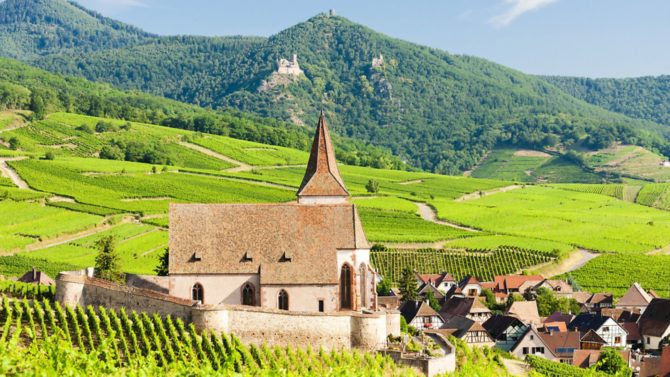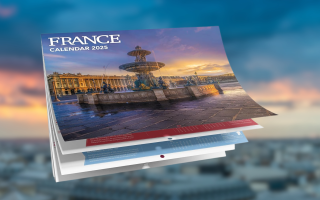An insider’s guide to France’s wine regions


Plan your next trip to France with our guide to the 11 French wine regions

53 appellations: including Alsace, Alsace Grands Crus, Crémant d’Alsace
Dominant grape varieties: Riesling, Muscat, Pinot Gris, Gewürztraminer
Wine area: 15,545ha
In the north-east of the country, close to Germany, the Alsace vineyards are protected by the Vosges mountains. The many different grape varieties which thrive here produce rich and aromatic wines, from dry and delicate to full-bodied – primarily though, Alsace is known for its dry and sweet white wines. The Alsace Wine Route, one of the oldest in France, covers 170km of landscapes rich with medieval villages, half-timbered houses, châteaux and Romanesque and Gothic churches, as well as the famous vineyards, and there is also a Vineyard Cycleway. Community wine events take place from April to October, and the region is also famous for its Christmas markets and has 26 Michelin-starred restaurants. The vineyards are in the Bas-Rhin and Haut-Rhin départements. Colmar, the capital of Alsatian wine, is particularly picturesque, as are the villages of Eguisheim, Hunawihr, Hunspach, Mittelbergheim and Riquewihr. The countryside is a mix of vineyards, forests and farmers’ fields, and includes the Ballons des Vosges regional nature park with its spectacular mountain scenery.

Beaujolais
12 appellations: including Brouilly, Chénas, Côte de Brouilly, Chiroubles, Fleurie, Juliénas, Morgon, Moulin-à-Vent, Régnié, St-Amour, Beaujolais-Villages, Beaujolais
Dominant grape varieties: Gamay, Chardonnay
Wine area: 15,733ha
Known world-wide for Beaujolais nouveau, which is famously uncorked every November, the wine-producing area is set within the Auvergne-Rhône-Alpes region, between Burgundy and Lyon. Like most of its wines, the nouveau is red. You can discover the pretty Beaujolais villages and rolling countryside along the 140km wine route, meet some of the 200 winemakers and sample some of the fabulous food this area offers, including Michelin-starred restaurants. Beaujolais was once a historic province but now the vineyards lie within the north of the Rhône and south of the Saône-et-Loire departments Away from the city of Lyon, France’s foodie capital, rolling hills and vineyards are dotted with pretty villages and towns such as Macon, Charolles, Oingt and Semur-en-Brionnais. Flights from the UK into Lyon make the area easy to access.

100 appellations: 23 origin-approved (AOC) regions, 44 origin-approved villages; 33 of the best wines listed as grands crus including Côte de Nuits, Côte de Beaune, Côte Chalonnaise, Chablis, Maconnais
Dominant grape varieties: (Red) Pinot noir, Gamay; (White) Chardonnay, Aligoté
Wine area: 28,715ha
Burgundy’s vineyard plots are uniquely known as climats; together they stretch 230km from Auxerre to Macon. The varied Burgundy wines are among the most famous in the world, created in villages such as Pommard, Gevrey-Chambertin, Puligny-Montrachet, St-Véran and Pouilly Fuissé. The regional capital Dijon is well worth a visit while towns such as Beaune are firm tourist favourites (the Hospices de Beaune hosts the most famous wine auction in the world), along with the area’s many châteaux, Romanesque churches and abbeys. The Côte de Nuits area is the heartland of the region’s Grand Crus. The ever-popular aperitif kir was created in Burgundy – an authentic one should be made from crème de cassis and Burgundy Aligoté wine. The Burgundy vineyards are quite widely spread, from the Yonne department in the north moving east into the Côte-d’Or and south into the Saône-et-Loire. As well as the vineyards, there are lovely canal and river locations, the Morvan regional nature park and popular towns and villages such as Beaune, Cluzy, Vézelay, Auxerre, Châteauneuf, Flavigny-sur-Ozerain, Macon and Semur-en-Brionnais. Although there are no airports in Burgundy, Lyon isn’t too far, especially from the southern vineyards, and there are good road and rail links.

___________________________________________________________________________
Related articles
French vineyards: 10 tips to make the most of your visit
Our favourite 10 wine producing towns in France
___________________________________________________________________________

1 appellation: Champagne
Dominant grape varieties: Chardonnay, Pinot Noir, Meunier
Wine area: 34,000ha
The most famous of all the world’s wines, and the only sparkling wine that can be called champagne, hails from this north-eastern corner of France. The two-stage fermentation was reputed to have been discovered by the monk Dom Pérignon – it may not be true but it’s a nice story, and he can certainly be credited with contributing to the technique that produced a successful white wine from red grapes. The vineyards divide into four regions – Montagne de Reims, Valle?e de la Marne, Côte des Blancs and Côte des Bar – which together comprise nearly 278,000 individual pieces of land, with an average surface area of two hectares. No visit to the area is complete without a tour of at least one of the champagne houses in Reims and Epernay, or a tasting tour of the producers based in the pretty villages. The champagne vineyards are mainly located in the Marne department. Other popular towns and villages include Châlons-en-Champagne, Chaumont, Langres, Troyes, Bar-sur-Aube and Les Riceys, and the region is also home to the leisure lake Lac du Chantercoq. The nearest airports are in Paris, but it’s an easy drive or train ride from the Channel ports.

85 appellations: including Muscadet, Rosé d’Anjou, Touraine, Saumur, Chinon, Pouilly-Fumé
Dominant grape varieties: (Red) Pinot Noir, Cabernet Franc, Gamay, Grolleau, Pineau d’Aunis, Malbec; (White) Chenin Blanc, Sauvignon, Melon de Bourgogne, Chardonnay
Wine area: 74,800ha
The largest UNESCO World Heritage Site in the world, recognised for its remarkable landscapes and châteaux, the Loire Valley is also known for its vineyards, which stretch from Nantes to Sancerre. Its 1,000km wine route is the longest in France, passing troglodyte homes, châteaux, gardens and royal abbeys. Here, the names of wines and châteaux, are synonymous: Chenonceau, Chambord, Brissac, Saumur, and Chinon. Wine districts include Muscadet, Anjou, Saumur, Touraine and Sancerre, producing a wide range of wines. You can meet the winemakers and sample their wares in 400 specially accredited cellars, while the more active can explore the vineyards by bike or follow the 800km of cycle paths along the River Loire. As the vineyards are spread along the River Loire, they stretch a fair distance from as far inland as the Cher and Loiret departments all the way to the Atlantic coast. The Loire Valley is an easy day’s drive from Channel ports and there are also UK flights to Angers, Nantes, Tours and Poitiers.

3 appellations: Savoie, Roussette de Savoie, Seysell
Dominant grape varieties: (Red) Mondeuse, Pinot Noir, Gamay, Persan; (White) Chardonnay, Jacquère, Roussanne, Altesse, Chasselas
Wine area: under 2,000ha
Although more noted for its mountainous landscapes and outdoor activities, the Alps also have vineyards, producing both white and red wines, plus a few rosés and the sparkling Crémant de Savoie. The wine route passes huge lakes (Léman, Bourget, Annecy and Aiguebelette), rivers and waterfalls, as well as medieval châteaux and villages such as Apremont and Jongieux. Savoie is known for its cheeses, including Reblochon and Beaufort – they make the perfect complement for a wine-tasting. You can enjoy the wines direct from the vineyards or at one of the 36 Michelin-starred restaurants in the Savoie Mont Blanc region. Sometimes separate and sometimes lumped in with Savoie, the Jura wine region has seven appellations, beautiful landscapes and more affordable property. With all those tourists flocking to the mountains in summer and winter, travel connections are good with airports at Geneva, Lyon, Grenoble and Chambéry, and even a ski train direct to the ski areas.

___________________________________________________________________________
Related articles
Road trip: explore Champagne country
Explore Champagne and Burgundy
___________________________________________________________________________

60 appellations including: St-Emilion, Pomerol, St-Estephe, Pauillac, St-Julien, Margaux, Haut Medoc, Listrac, Moulis, Médoc, Graves, Pessac-Léognan, Sauternes
Dominant grape varieties: (Red) Merlot, Cabernet Franc, Cabernet Sauvignon; (White) Sémillon, Sauvignon, Muscadelle
Wine area: 120,000ha
With a wine-making tradition stretching back 20 centuries, Bordeaux is France’s premier fine-wine region. It is renowned for its elegant châteaux (6,000 of them), which give their names to some of the world’s most famous wines – Château Lafite-Rothschild, Château Latour, Château Mouton-Rothschild, Château Margaux, Château Haut-Brion, Château Cheval Blanc, Château Ausone, Château Pétrus, Château Le Pin… You’ll also find historic villages and towns, not to mention the eponymous city, much revamped over recent years. Bordeaux’s wide variety of wines is matched by its landscapes, from the Atlantic Ocean to the River Garonne and the Pyrénées mountains. Wine areas include the Médoc, Blaye and Bourg, the Libournais, Entre Deux Mers, Graves and Sauternais, as well as Bordeaux and Bordeaux Supérieur. The area obviously centres on Bordeaux, but wine towns like St-Emilion are also popular as well as seaside resorts such as Arcachon – you don’t have to travel far from the vineyards to the beautiful Atlantic coastline of the Côte d’Argent.

36 appellations including: Languedoc, Corbières, Faugères, Minervois, St-Chinian
Dominant grape varieties: (Red) Grenache, Mourvèdre, Syrah, Carignan; (White) Bourboulenc, Grenache Blanc, Marsanne, Roussanne, Vermentino, Picpoul
Wine area: 245,000 hectares
Stretching from the mountains to the sea, the vast Languedoc wine region was traditionally known for producing quantity over quality, but that has changed over recent years with local winemakers keen to bring the standards up to compete with other wine-producing regions. This sunny southern area produces a variety of wines – red, white, rosé and sparkling – and everywhere you look, there’s a vineyard. The wine area includes the vineyards of the Minervois, Corbières, Fitou, St-Chinion, Faugères, Picpoul de Pinet and Limoux – the sparkling Blanquette de Limoux is said to be the oldest wine in the world, even older than champagne. The region combines striking scenery, from the peaks of the Pyrénées to the shores of the Mediterranean, with a rich cultural and architectural heritage – it’s home to the Pont du Gard, Nîmes arena, Cathar castles, the Canal du Midi and the walled city of Carcassonne, as well as numerous abbeys, medieval villages and fishing ports.
9 appellations including: Côtes de Provence, Coteaux d’Aix-en-Provence, Les Baux-de-Provence, Coteaux Varois en Provence
Dominant grape varieties: (Red) Syrah, Grenache, Cinsault, Mourvèdre, Tibouren, Carignan, Cabernet Sauvignon; (White) Rolle, Ugni Blanc, Sémillon
Wine area: 43,700ha
Along the Mediterranean coast and into the hinterland, Provence has been home to vineyards for thousands of years. From Nice to the Camargue, the Provence wine route combines 430 vineyards and cooperative wine cellars. Although Provence is known for its rosé, it also produces strong well-rounded reds as well as refreshing and aromatic white wines. Settled by the Greeks and Romans (who first planted the vines), it’s clear that this southern hotspot has long been popular with settlers. Holidaymakers throng to its market towns, historic villages and Mediterranean coast, eager to soak up all that southern sunshine, which also ripens all the grapes of course. The region was popular with painters too, such as Cézanne and Van Gogh, who immortalised its landscapes. You can see their masterpieces in museums throughout the region, and also visit Roman monuments. Popular towns include Aix-en-Provence, Fréjus, Les Baux-de-Provence and Brignoles – the vineyards even extend to the coastal towns of Bandol and Cassis.
___________________________________________________________________________
Related articles
France’s top 10 wine experiences
10 outstanding vineyards in France you have to visit
___________________________________________________________________________
Rhône valley
45 appellations including: Côtes-du-Rhône, Côtes-du-Rhône Villages, Luberon, Ventoux, Grignan-les-Adhémar, Costières-de-Nîmes, Clairette-de-Bellegarde, Duché-d’Uzès, Côtes-du-Vivarais
Dominant grape varieties: (Red) Syrah, Grenache, Mourvèdre; (White) Viognier, Roussanne, Marsanne, Grenache Blanc, Bourboulenc
Wine area: 71,000ha
Stretching from Lyon to the Camargue, the Rhône Valley vineyards produce some of France’s best known wines. The wine area divides into the more hilly north referred to in French as Rhône septentrional (hilly) and the plains and gentle slopes of the south or Rhône méridional. The wines are mostly red, with robust reds and aromatic whites in the north, and full-bodied reds, expressive whites and fruity rosés in the south. There are sweet wines too. Some 14 wine routes wind through historic villages such as Hermitage, Côte-Rôtie, Beaumes-de-Venise and Châteauneuf-du-Pape. The landscape ranges from mountains to lavender fields and olive groves, while manmade sites include the Palace of the Popes in Avignon or the Roman Pont du Gard. There are historic towns and cities to visit too, among them Lyon, Vienne, Valence, Vaison la Romaine, Orange, Avignon and Nîmes.
South-west
15 appellations including: Bergerac, Buzet, Cahors, Côtes de Duras and Côtes du Marmandais
Dominant grape varieties: (Red) Cabernet Franc, Cabernet Sauvignon, Merlot; (White) Sémillon, Sauvignon, Muscadelle
Wine area: 50,300ha
The south-west vineyards cover 12 districts, from the Massif Central plateau to the Gascony hills and the Pyrénées mountains, taking in towns such as Toulouse, Cahors, Auch, Albi, Rocamadour and Conques, as well as the St-Jacques-de-Compostelle pilgrim trail, Canal du Midi and Millau Viaduct. The area is also home to 29 Plus Beaux Villages, 33 World Heritage-listed monuments and 22 Michelin-starred chefs. Wines cover most options, ranging from light reds or reds to keep and mature, to soft or full-bodied rosés, and dry, mellow or sparkling whites; they go hand in hand with local produce such as foie gras, truffles and Roquefort cheese. The south-west is a less distinct wine region than others, spreading across a huge area. The vineyards stretch south and inland of Bordeaux, mainly within Aquitaine and the western part of the Midi-Pyrénées (now part of the Nouvelle Aquitaine and Occitanie regions). They divide into sub-regions around the River Dordogne (e.g. Bergerac, Duras, Monbazillac), River Garonne (e.g. Cahors, Buzet, Gaillac, Fronton, Marcillac), Gascony (e.g. Madiran) and Basque country (Béarn, Jurancon).
Share to: Facebook Twitter LinkedIn Email


